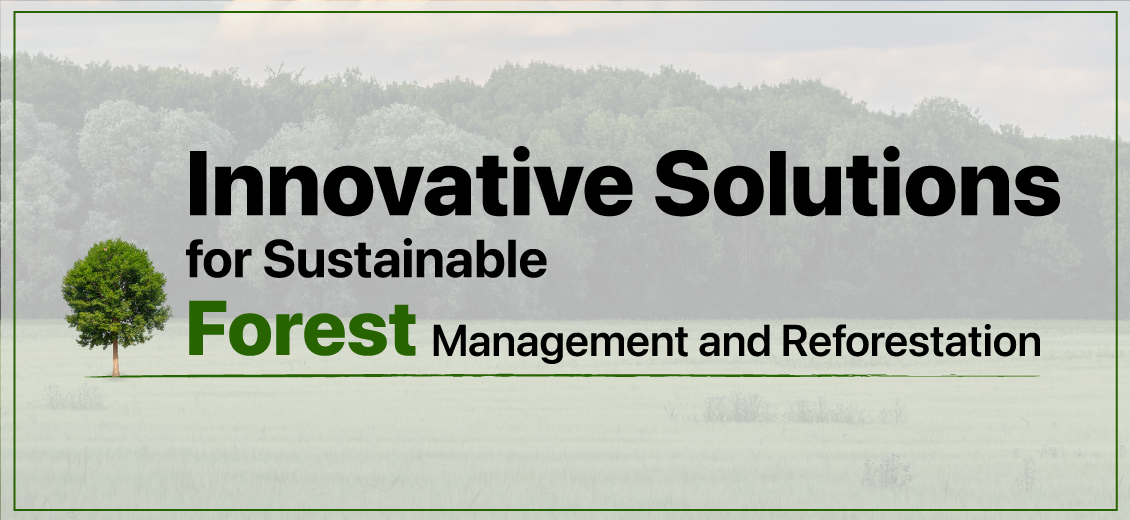Innovative Solutions for Sustainable Forest Management and Reforestation
Blogs Home
- 21 Mar 2023

On a car journey through spiraling roads in Himalayan pine forests, we encountered a rare and sudden jam in a remote area. When we got down, we saw much ahead the lower slope was burning, some cars returning and people guessing how the fire started. The dhaba-wala was throwing water with buckets on the trees on fire to save their little setup. By the time I reached my village, neither people were home nor there was any forest fire. All of them had averted the spreading flames by a daylong emptying of water buckets into the forest.
Anthropogenic or natural forest fires are not the only problem that ail forests worldwide. Deforestation and forest degradation owing to agriculture expansion, the spread of invasive species, clearing for developmental projects and over harvesting by commercial players are responsible for shrinking global forests. Forests are an important part of the nature cycle, water cycle and food cycle, attracting natural rainfall, housing immense biodiversity, natural food, fuel, fodder and provide a range of ecosystem services. Their role as carbon sink and oxygen generators attributes to them the 'lungs of earth' status. They are responsible for micro-climate regulation and mitigating climate change, preventing soil erosion, landslides, floods and even dampening the impact of tsunamis and cyclones in coastal areas. The cultural services granted by forests include recreation, health and spiritual benefits.
Globally between 2015 to 2020, approximately 10 million hectares of forest area loss per year has happened as per the FAO State of Forests Report. Being home to the majority of terrestrial biodiversity and still being under continued loss, calls for sustainable forest management and reforestation.
Sustainable Forest Management
Sustainably managing forest refers to maximising the benefits of forests provided it is economically and ecologically viable and socially just to the local community. It takes care of the needs of the present generation while not compromising the resources for future ones. This leads to an overall increase in the health of forests and the planet simultaneously boosting livelihood support to people and improving ecosystem services provided by forests.
Stakeholders of Sustainable Forest Management
- Government: The most important one as it frames the policies and regulations dealing with forests. In year 2011, United National Future Policy Award for forest was presented to Rwanda government for its exemplary policies towards conservation and sustainable development of forest from border to border.
- People: People living in or near forests are another important stakeholder as they value forests as a whole not just for their economic benefits.
- Commercial users: Timber and other forest-based goods companies predominantly consider forests as an economic resource to be exploited.
- NGOs and environmentalists: Often work towards the goals of sustainable management and regeneration of forests.
- Educational and research institutes: That raise awareness among children, youth and other participants on forest value, deforestation and reforestation. Research establishments are engaged in monitoring forest health, deforestation, regeneration and new technologies for these. They help governments in framing regional policies appropriate for sustainable forest management.
Reforestation
Replanting trees in areas previously covered by forest that were lost to deforestation from natural or anthropogenic sources is defined as reforestation. The alarming rate of global temperature rise makes the need for SFM and forest expansion urgent now more than ever. Forests in themselves are dynamic living entities with an equal (as humans) right to survive and flourish even without being used by external systems.
Innovations for SFM and Reforestation
- Landmark innovative legislations: In 2019, El Salvador recognised forests as living entities with their own rights, making it a responsibility of all citizens to care for and respect forests. In another recent law, the European Union banned the import of products originating from deforested lands anywhere in the world. In 2006, India adopted Forest Rights Act recognising the rights of forest dwelling communities, increasing their access to forest and a chance to self-rehabilitate jungles. But so far only 3% of rights have been transferred as counter-acting national or state-level acts exist. It is necessary for states to work on new comprehensive legislations that help regulate the rights and the roles of stakeholders to help achieve sustainable forest management. The need for strict legislation on spreading only indigenous tree species in respective regions also should be catered to.
- Land covers or activities that encroach on forests: increasing agriculture outputs from same patch of land lies at the base of tackling deforestation. Additionally, innovation in supply and need for forest-based products like timber may help in reducing the negative impact of industry on forests. Introduction of corporate social responsibilities by companies that consume forest products and emit carbon dioxide is a positive step. Agroforestry innovations help in boosting agriculture output at the same time increasing forest cover in rural and urban farmlands. Sustainable Agro-works, Odisha has agro-forestry model working with farmers. Saytrees plants multi-layer fruit and timber trees on farmlands. Several startups are working on food forest models providing sustainable livelihood to rural communities. Anandaa farm near Chandigarh is an example of a permaculture food forest. Shifting timber companies to timber plantations is a smart strategy. In the US, genetically modified poplar trees that grow faster, absorb more carbon have been developed and planted. The effort seeks to meet demands of timber industry reducing load on forests for both wood and carbon sequestration. Use of engineered wood products should be promoted in place of pure wood as they utilise wood scraps to manufacture wooden products. Cross-laminating timber is successfully used by a company called XLam, Australia. Wood DNA-based tracking of illegal logging is being used in Australia to preserve forests. Mandatory timber recycling policies need to be framed for reducing wood wastage. Avani Bioenergy NGO uses fallen pine needles to prevent forest fires and generate electricity in Uttarakhand.
- Educational and research innovations: teaching outdoors, nature walks, and curriculum based outdoor experiments are great initiatives at an early phase in children's life being conducted in School Forests of USA. Seed pencils and seed balls are another small but unique practice to bring participation of children in forest care. Satellite imagery, laser data, GPS, Unmanned Aerial Vehicle and other remote sensing techniques are being used to map and monitor forests and biodiversity by research institutions.
- Social innovations: tribal communities of Uttarakhand, Karnataka and Rajasthan (Chipko aandolan, Appiko movement, Bishnoi community) have traditionally set a benchmark for people's role in forest management. Some countries have adopted community based or tribal forest management to use their indigenous knowledge for local forests. Social innovation leads to better co-operation between different stakeholders and supports rural livelihoods. 'Forest Sharing' is an innovative concept emerging in Europe where most of the forest land is privately owned.
- Innovation for reforestation: drones have been used for speedy reforestation. Platforms like Ecoasia, a web browser plant trees for your every few searches. Greenstands application links tree growers and funders. Quick forest regeneration using Miyaki technique is being employed by 'Billion Towards the Global Trillion', India. Environmentalists, forest lovers and grassroot communities have not just reforested but turned new lands to forests regenerating whole landscapes (Examples: Aranya Tamil Nadu by Mr D. Saravanan regenerated 100 acres forest; a cooperative in Dharmapuri, Tamil Nadu under Piyush Manush conserved rainwater to regenerate forest; Ms. Sabarmatee in Orissa formed NGO Sambhav reinstating degraded forest land; Manvendra and his team regenerated 500 acres of dry land into forest using traditional wisdom). Aravalli biodiversity park was converted to 350 acres forest from a sand mine by joint effort of locals, NGO (I am Gurgaon) and ecologist Vijay Dhasmana. A coastal village of Orissa -Barakot under the animal lover Mr Vijay Kumar Kavi regenerated 25 acres mangrove forest. Even in the cold desert of Kinnaur retired bureaucrat Mr MD Negi afforested 65 acres of land.
Conclusion
Strong legislations towards a forest regenerative goal are needed worldwide. El Salvador has been able to regenerate its forest by involving farmers and the local community in regeneration. Forest laws need to identify properly all the stakeholders and establish clear roles and rights for each. Due recognition needs to be given to resident communities in such legislations. NGOs and research institutions should facilitate the latest developed skillsets and technologies through periodic programmes for villages living in forests. Mandatory recycling of timber products, support to products based on fast-regenerating trees like bamboo, poplar should be promoted. Agroforestry and forest regeneration of wasteland for commercial purposes should be focused on. Artificial intelligence, remote sensing and big data solutions should be utilised to revive forests. Financial incentives and aid to communities and individuals involved would promote the mass involvement in SFM and provide a ray of hope for our forests.
Sakshi Naithani
Sakshi has done her Masters in Geography from Delhi School of Economics, University of Delhi. She is currently pursuing Ph.D. in natural hazard risk assessment from Indian Institute of Remote Sensing-Kumaun University. When not engaged in research work, she loves to write poetry.
Blogs Home





-min.jpg)